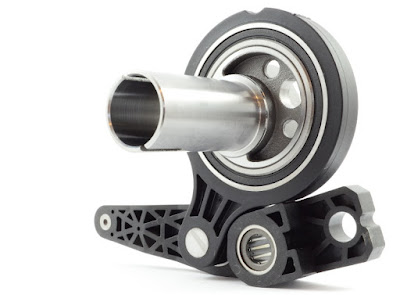Online monitoring system for bearing industry
In the rapidly growing technological landscape, online monitoring systems have revolutionized the industrial sector, empowering businesses with real-time insights and data-driven decision-making capabilities. In various industrial sectors, such as automotive, aerospace, and power generation, bearings are critical components that require precise monitoring to ensure optimal performance and longevity. Bearings play a crucial role in minimizing friction and wear in rotating machinery, and any malfunction or failure can result in substantial losses, jeopardizing the entire operation. With the advent of online monitoring systems for bearings, industries can effectively monitor bearing health, detect faults, and take proactive measures to prevent unscheduled downtime, maintenance, and repair costs. This blog post delves into the online monitoring system for the bearing industry, its advantages, and applications. It highlights how this technology utilizes sensors, data analytics, and machine learning to provide in-depth insights into bearing performance, temperature, vibration, and other parameters that impact the bearing's lifecycle. Furthermore, it discusses the crucial role of online monitoring in predictive maintenance,
1. Introduction to the importance of bearing monitoring in industrial machinery.
Industrial machinery relies heavily on the performance of its bearings. The bearing is one of the most crucial components in rotating machines; it allows the machine to run smoothly and efficiently while reducing the amount of wear and friction between moving parts. Bearings can fail to function properly due to various reasons, such as improper maintenance, contamination, or overloading. If bearings are not properly monitored, it can lead to costly damages, unplanned shutdowns, and unnecessary replacement parts. Thus, bearing monitoring is essential to maintain optimal production efficiencies, prevent unplanned downtime, and maximize equipment lifespan. In this document, we will discuss the importance of bearing monitoring in industrial machinery and introduce our online monitoring system for the bearing industry.
2. Explanation of online monitoring systems and their benefits for the bearing industry.
An online monitoring system for the bearing industry is an automated system that supervises the status of bearings and offers real-time monitoring, analysis, and feedback. This system provides a continuous tracking service of important parameters such as temperature, vibration, and lubrication conditions, which is critical to ensure the efficient functioning of the bearing and to prevent premature damage or failure. The online monitoring system for the bearing industry is beneficial in many respects. Firstly, it helps reduce sudden and unwanted downtime associated with unexpected bearing failures by issuing early warning alerts to operators, enabling them to take preventive action before any significant damage occurs. Secondly, it enables data-driven predictive maintenance, which significantly reduces maintenance costs while increasing the overall lifespan of the bearings. Finally, by making real-time data accessible and visual, online monitoring systems facilitate better decision-making and improved communication between operators, technicians, and other stakeholders.
3. Overview of the different types of online monitoring systems available for bearing industry, including vibration analysis and oil analysis.
The use of online monitoring systems for bearing industry has become increasingly popular in recent years, as it enables businesses to monitor the status of bearings and detect any potential issues quickly and efficiently. There are several types of online monitoring systems available, including vibration analysis and oil analysis. Vibration analysis involves the use of sensors to measure the vibrations of rotating machinery, such as bearings, and provides information about the condition of the equipment. This information can be used to predict when maintenance or repairs are needed, thus minimizing downtime and reducing costs. Oil analysis, on the other hand, involves regular testing of the lubricating oil used in bearings to detect contaminants, wear metals, and other signs of potential problems. This helps businesses to identify issues early on, allowing for preventative maintenance and reducing the risk of serious equipment failure. Other types of online monitoring systems include temperature sensors, acoustic emission testing, and ultrasonic testing, all of which have their own unique benefits and applications.
4. Discussion of the key features to look for in an effective online monitoring system, such as real-time monitoring, data analysis, and automatic reporting.
As the bearing industry continues to grow and become more complex, companies must implement an effective online monitoring system to ensure optimal performance and prevent downtime. When choosing an online monitoring system, there are several key features to consider, including real-time monitoring, data analysis, and automatic reporting. Real-time monitoring allows for immediate detection of potential issues, reducing the risk of catastrophic failures and minimizing time to repair. Data analysis enables the identification of trends, patterns, and anomalies, providing valuable insights into the overall health of the equipment. Automatic reporting ensures that stakeholders are informed of any issues and can quickly take action to resolve them. An effective online monitoring system must also be easy to use, with user-friendly interfaces that are accessible to all team members. By investing in a robust online monitoring system that incorporates these features, bearing industry companies can ensure maximum uptime, avoid unnecessary maintenance costs, and increase overall profitability.
5.Online monitoring system for the bearing industry.
The number "5" plays a significant role in the online monitoring system for the bearing industry. The system relies on a five-step process to provide real-time data and identify potential issues with bearings. These steps include data acquisition, signal preprocessing, feature extraction, fault diagnosis, and prognosis. Through this process, the system can accurately detect and diagnose bearing faults, providing timely notifications and reducing downtime. Additionally, the system can generate reports and analyses to aid in proactive maintenance and overall cost savings. In conclusion, the incorporation of the number "5" in the system's process is a testament to its effectiveness and reliability in the bearing industry.
In conclusion, the implementation of an online monitoring system for the bearing industry can bring significant benefits such as a reduction in downtime, avoidance of catastrophic failures, and an increase in productivity. It allows for the continuous monitoring of machinery to detect and diagnose problems before they become critical, giving maintenance teams the ability to take corrective action as needed. As industries continue to rely on complex machinery to increase efficiency and production, developing online monitoring systems will become even more critical. By implementing this system, companies can create reliable and modern maintenance practices that will not only profit their businesses but can also ensure the safety of their employees.




Megjegyzések
Megjegyzés küldése